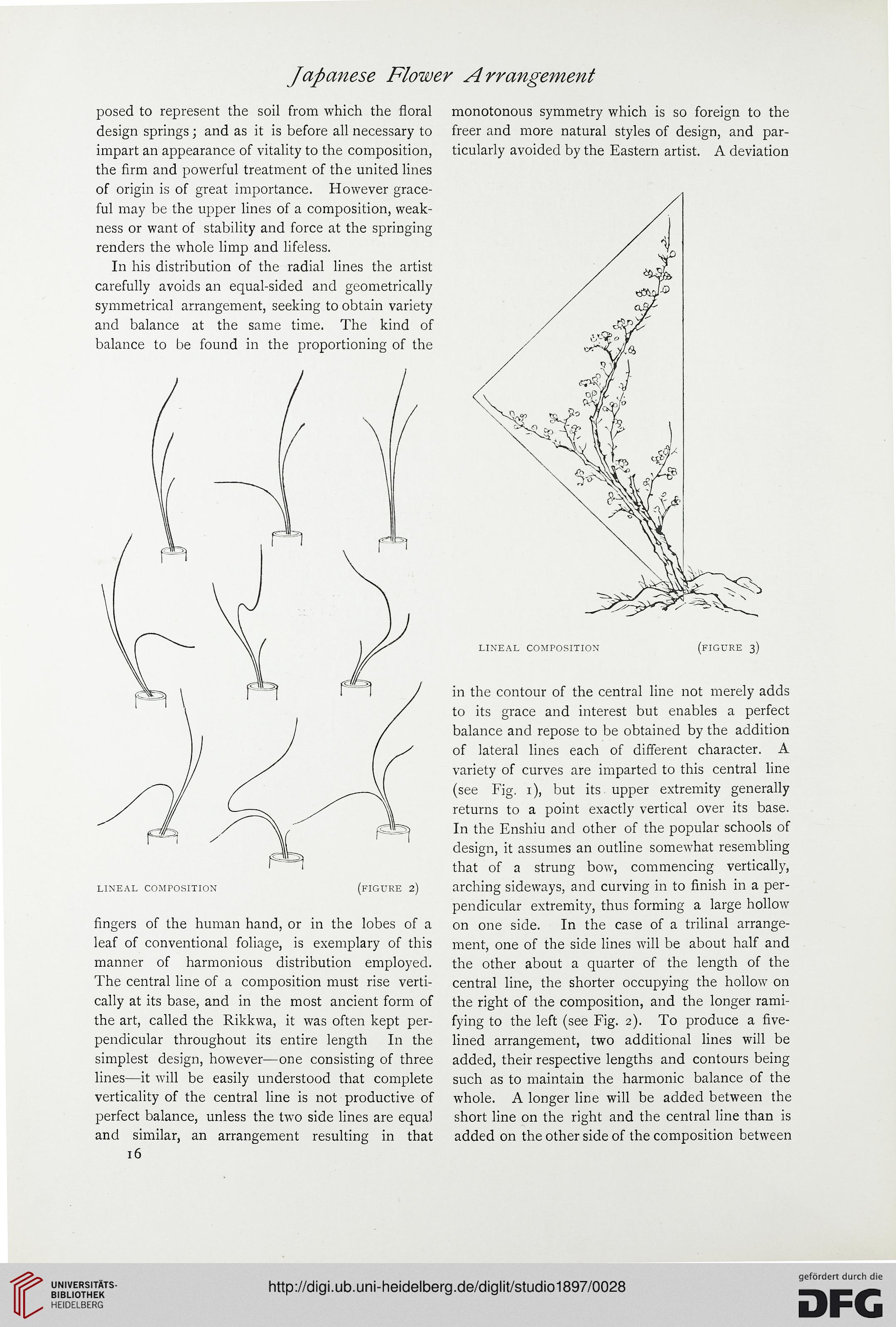Japanese Flower Arrangement
posed to represent the soil from which the floral
design springs; and as it is before all necessary to
impart an appearance of vitality to the composition,
the firm and powerful treatment of the united lines
of origin is of great importance. However grace-
ful may be the upper lines of a composition, weak-
ness or want of stability and force at the springing
renders the whole limp and lifeless.
In his distribution of the radial lines the artist
carefully avoids an equal-sided and geometrically
symmetrical arrangement, seeking to obtain variety
and balance at the same time. The kind of
balance to be found in the proportioning of the
LINEAL COMPOSITION (FIGURE 2)
fingers of the human hand, or in the lobes of a
leaf of conventional foliage, is exemplary of this
manner of harmonious distribution employed.
The central line of a composition must rise verti-
cally at its base, and in the most ancient form of
the art, called the Rikkwa, it was often kept per-
pendicular throughout its entire length In the
simplest design, however—one consisting of three
lines—it will be easily understood that complete
verticality of the central line is not productive of
perfect balance, unless the two side lines are equal
and similar, an arrangement resulting in that
16
monotonous symmetry which is so foreign to the
freer and more natural styles of design, and par-
ticularly avoided by the Eastern artist. A deviation
LINEAL COMPOSITION (FIGURE 3)
in the contour of the central line not merely adds
to its grace and interest but enables a perfect
balance and repose to be obtained by the addition
of lateral lines each of different character. A
variety of curves are imparted to this central line
(see Fig. i), but its upper extremity generally
returns to a point exactly vertical over its base.
In the Enshiu and other of the popular schools of
design, it assumes an outline somewhat resembling
that of a strung bow, commencing vertically,
arching sideways, and curving in to finish in a per-
pendicular extremity, thus forming a large hollow
on one side. In the case of a trilinal arrange-
ment, one of the side lines will be about half and
the other about a quarter of the length of the
central line, the shorter occupying the hollow on
the right of the composition, and the longer rami-
fying to the left (see Fig. 2). To produce a five-
lined arrangement, two additional lines will be
added, their respective lengths and contours being
such as to maintain the harmonic balance of the
whole. A longer line will be added between the
short line on the right and the central line than is
added on the other side of the composition between
posed to represent the soil from which the floral
design springs; and as it is before all necessary to
impart an appearance of vitality to the composition,
the firm and powerful treatment of the united lines
of origin is of great importance. However grace-
ful may be the upper lines of a composition, weak-
ness or want of stability and force at the springing
renders the whole limp and lifeless.
In his distribution of the radial lines the artist
carefully avoids an equal-sided and geometrically
symmetrical arrangement, seeking to obtain variety
and balance at the same time. The kind of
balance to be found in the proportioning of the
LINEAL COMPOSITION (FIGURE 2)
fingers of the human hand, or in the lobes of a
leaf of conventional foliage, is exemplary of this
manner of harmonious distribution employed.
The central line of a composition must rise verti-
cally at its base, and in the most ancient form of
the art, called the Rikkwa, it was often kept per-
pendicular throughout its entire length In the
simplest design, however—one consisting of three
lines—it will be easily understood that complete
verticality of the central line is not productive of
perfect balance, unless the two side lines are equal
and similar, an arrangement resulting in that
16
monotonous symmetry which is so foreign to the
freer and more natural styles of design, and par-
ticularly avoided by the Eastern artist. A deviation
LINEAL COMPOSITION (FIGURE 3)
in the contour of the central line not merely adds
to its grace and interest but enables a perfect
balance and repose to be obtained by the addition
of lateral lines each of different character. A
variety of curves are imparted to this central line
(see Fig. i), but its upper extremity generally
returns to a point exactly vertical over its base.
In the Enshiu and other of the popular schools of
design, it assumes an outline somewhat resembling
that of a strung bow, commencing vertically,
arching sideways, and curving in to finish in a per-
pendicular extremity, thus forming a large hollow
on one side. In the case of a trilinal arrange-
ment, one of the side lines will be about half and
the other about a quarter of the length of the
central line, the shorter occupying the hollow on
the right of the composition, and the longer rami-
fying to the left (see Fig. 2). To produce a five-
lined arrangement, two additional lines will be
added, their respective lengths and contours being
such as to maintain the harmonic balance of the
whole. A longer line will be added between the
short line on the right and the central line than is
added on the other side of the composition between




